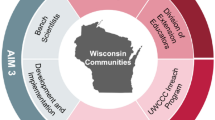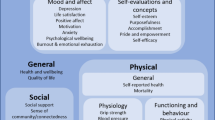Abstract
Preparing healthy community members with timely communications prior to engaging them in a request to donate biospecimens promises to improve the experience of biobanking participation. To this end, a qualitative study was conducted to assess community member knowledge, attitudes, beliefs, and informational needs about cancer-related biospecimen collection in a large metropolitan area in southwest Florida. The study utilized purposive sampling techniques to recruit a total of 95 participants to participate in 12 focus groups, segmented by race/ethnicity and language preference (mixed race, African American only, and Spanish speaking) and age (18–29, 30–54, and 55 and older). Focus group interviews were analyzed using content analysis to identify emergent themes. Overall, participants in the 30 years and older groups were favorable toward participating in biobanking if their concerns were addressed, such as confidentiality and consent issues, in contrast to participants aged 18–29 who were more skeptical. For all participants, the desire to participate in research that seeks new cancer treatments outweighed mistrust. Moreover, many cited the potential scientific benefit for future generations as a primary motivator. Finally, in some groups a therapeutic misconception was expressed, where participants expressed a willingness to forego confidentiality of their health status in exchange for therapeutic benefit. This study contributes to the literature on community perceptions of the benefits and barriers of biobanking and adds to the development of meaningful education communication priming tools to advance understandings about biobanking.
Similar content being viewed by others
References
Bauer K, Taub S, Parsi K (2004) Ethical issues in tissue banking for research: a brief review of existing organizational policies. Theor Med Bioeth 25(2):113–142
Hewitt RE (2011) Biobanking: the foundation of personalized medicine. Curr Opin Oncol 23(1):112–119
Khoury MJ, Millikan R, Little J, Gwinn M (2004) The emergence of epidemiology in the genomics age. Int J Epidemiol 33(5):936–944
Morente MM, Fernández PL, Alava E (2008) Biobanking: old activity or young discipline? Semin Diagn Pathol 25(4):317–322
Barr M (2006) I’m not really read up on genetics: biobanks and the social context of informed consent. BioSocieties 1(02):251–262
Jack AL, Womack C (2003) Why surgical patients do not donate tissue for commercial research: review of records. BMJ 327(7409):262
Compton C (2007) Cancer biobanking: the American perspective. Eur J Cancer Suppl 5(8):5–6
O’Doherty K, Hawkins A (2010) Structuring public engagement for effective input in policy development on human tissue biobanking. Public Health Genomics 13(4):197–206
Goldman RE, Kingdon C, Wasser J et al (2008) Rhode Islanders’ attitudes towards the development of a statewide genetic biobank. Per Med 5(4):339–359
Secko DM, Preto N, Niemeyer S, Burgess MM (2009) Informed consent in Biobank research: a deliberative approach to the debate. Soc Sci Med 68:781–789
Mayo Clinic. DNA Biobanking in Olmstead County, a deliberative community engagement. Available from: http://biobank.mayo.edu. Accessed 13 May 2009
Deschênes M, Sallée C (2005) Accountability in population biobanking: comparative approaches. J Law Med Ethics 33:41–53
Chalmers D (2011) Genetic research and biobanks. Methods Mol Biol 675:1–37
Appelbaum PS, Roth LH, Lidz CW, Benson P, Winslade W (1987) False hopes and best data: consent to research and the therapeutic misconception. Hastings Cent Rep 17(2):20–24
Lidz C, Appelbaum P, Grisso T, Renaud M (2004) Therapeutic misconception and the appreciation of risks in clinical trials. Soc Sci Med 58:1689–1697
Morrell B, Lipworth W, Axler R, Kerridge I, Little M (2011) Cancer as rubbish: donation of tumor tissue for research. Qual Health Res 21:(X1)
Johnsson L, Hansson MG, Eriksson S, Helgesson G (2008) Patients’ refusal to consent to storage and use of samples in Swedish biobanks: cross sectional study. BMJ 337:a345
Watanabe M, Inoue Y, Chang C et al (2011) For what am I participating? The need for communication after receiving consent from biobanking project participants: experience in Japan. J Hum Genet 56(5):358–363
Axler RE, Irvine R, Lipworth W, Morrell B, Kerridge IH (2008) Why might people donate tissue for cancer research? Insights from organ/tissue/blood donation and clinical research. Pathobiology 75(6):323–329
Murphy J, Scott J, Kaufman D, Geller G, LeRoy L, Hudson K (2009) Public perspectives on informed consent for biobanking. Am J Public Health 99(12):2128–2134
Hede K (2006) New biorepository guidelines raise concerns. J Natl Cancer Inst 98(14):952–954
Hoeyer K, Olofsson B-O, Mjörndal T, Lynöe N (2005) The ethics of research using biobanks: reason to question the importance attributed to informed consent. Arch Intern Med 165:97–100
Wendler D (2006) One-time general consent for research on biological samples. BMJ 332:544–547
Meade C, Menard J, Martinez D, Calvo A (2007) Impacting health disparities through community outreach: utilizing the CLEAN look (culture, literacy, education, assessment, networking). Cancer Control 14(1):70–77
Yeatman TJ, Mule J, Dalton WS, Sullivan D (2008) On the eve of personalized medicine in oncology. Cancer Res 68(18):7250–7252
Morgan DL (1996) Focus groups. Annu Rev Sociol 33:129–152
Meade CD (2003) Cancer care for diverse populations: relevant communications and research. Cancer Control 10(5 Suppl):1–2
Quinn GP, Thomas KB, Hauser K, Rodriguez NY, Rodriguez-Snapp N (2008) Evaluation of educational materials from a social marketing campaign to promote folic acid use among Hispanic women: insight from Cuban and Puerto Rican ethnic subgroups. J Immigr Minor Health 11(5):406–414
Goodson ML, Vernon BG (2004) A study of public opinion on the use of tissue samples from living subjects for clinical research. J Clin Pathol 57(2):135–138
Wendler D, Emanuel E (2002) The debate over research on stored biological samples: what do sources think? Arch Intern Med 162(13):1457–1462
Elwyn G, Edwards A, Wensing M, Hood K, Atwell C, Grol R (2003) Shared decision making: developing the OPTION scale for measuring patient involvement. Qual Saf Health Care 12(2):93–99
Charmaz K (2006) Constructing grounded theory: a practical guide through qualitative analysis. Sage Publications, Thousand Oaks
VERBI Software. MAXQDA 10 2010. Marburg, Germany
U.S. Preventive Services Taskforce (2009) Screening for breast cancer: U.S. Preventive Services Task Force recommendation statement. Ann Intern Med 151(10):716–726, W-236
Skloot R (2010) The Immortal Life of Henrietta Lacks. Random House, New York
Hawkins AK (2010) Biobanks: importance, implications and opportunities for genetic counselors. J Genet Couns 19(5):423–429
Tanne JH (2010) President Obama apologises to Guatemala over 1940s syphilis study. BMJ 341:c5494
Scharff DP, Mathews KJ, Jackson P, Hoffsuemmer J, Martin E, Edwards D (2010) More than Tuskegee: understanding mistrust about research participation. J Health Care Poor Underserved 21(3):879–897
Goebel JW, Pickardt T, Bedau M et al (2010) Legal and ethical consequences of international biobanking from a national perspective: the German BMB-EUCoop project. Eur J Hum Genet 18(5):522–525
Forsberg JS, Eriksson S, Hansson MG (2010) Changing defaults in biobank research could save lives too. Eur J Epidemiol 25(2):65–68
Beskow LM, Dean E (2008) Informed consent for biorepositories: assessing prospective participants’ understanding and opinions. Cancer Epidemiol Biomarkers Prev 17(6):1440–1451
Financial disclosure
The project described was supported by grant number U01 CA114627-05S2 from the Center to Reduce Cancer Health Disparities at the National Cancer Institute. Its contents are solely the responsibility of the authors and do not necessarily represent the official views of the NCI.
Author information
Authors and Affiliations
Consortia
Corresponding author
Rights and permissions
About this article
Cite this article
Luque, J.S., Quinn, G.P., Montel-Ishino, F.A. et al. Formative Research on Perceptions of Biobanking: What Community Members Think. J Canc Educ 27, 91–99 (2012). https://doi.org/10.1007/s13187-011-0275-2
Published:
Issue Date:
DOI: https://doi.org/10.1007/s13187-011-0275-2




